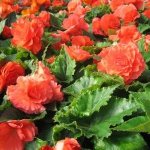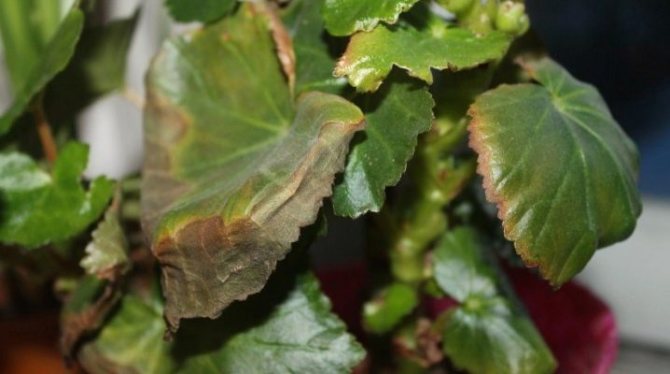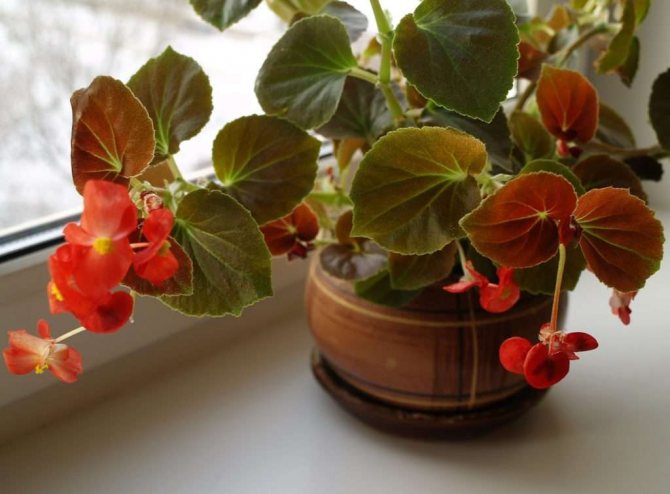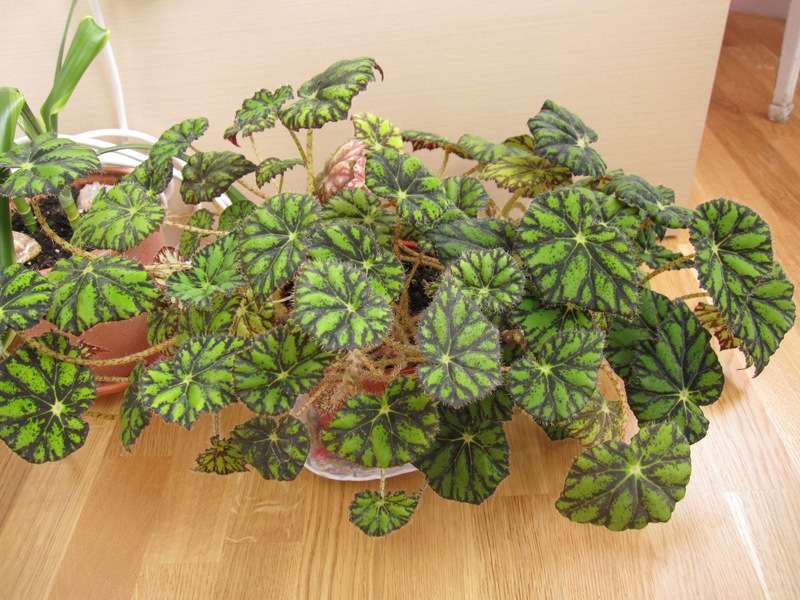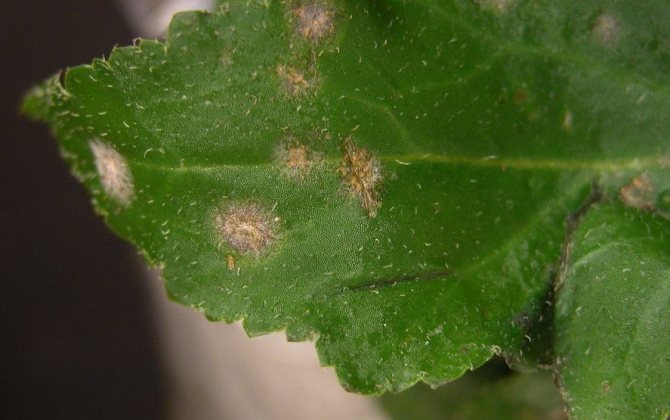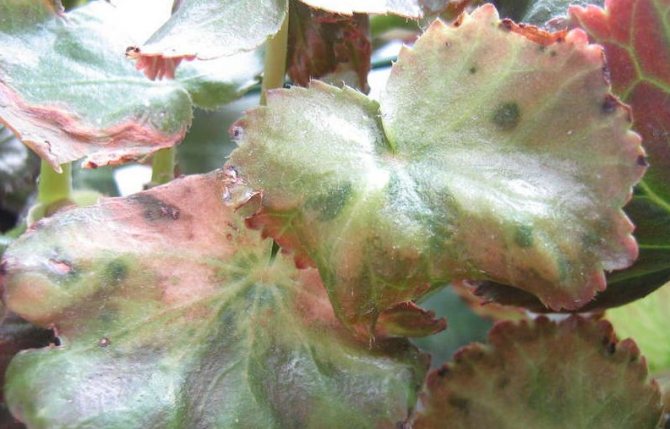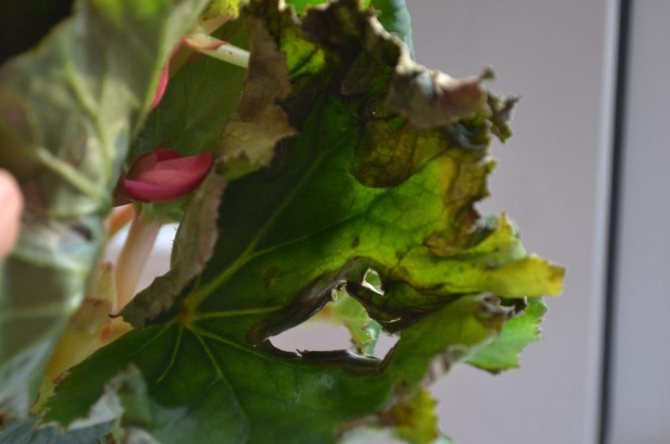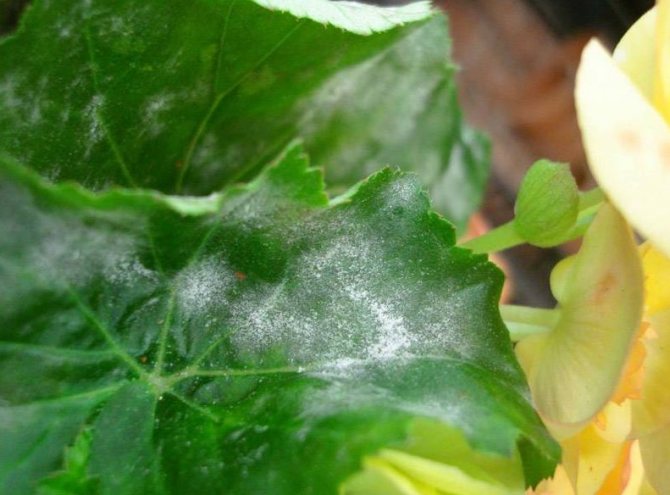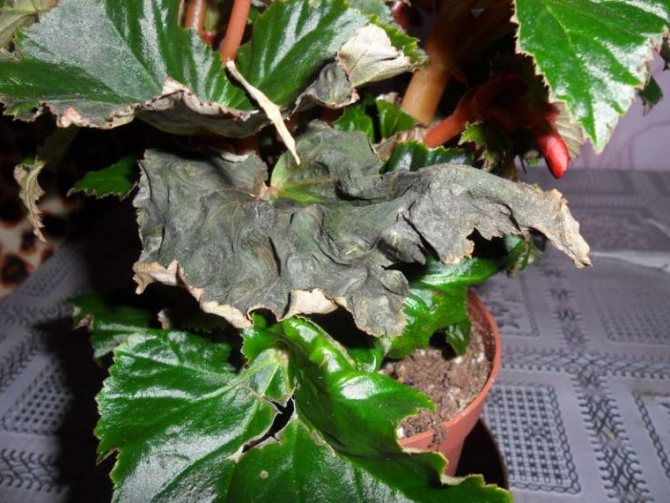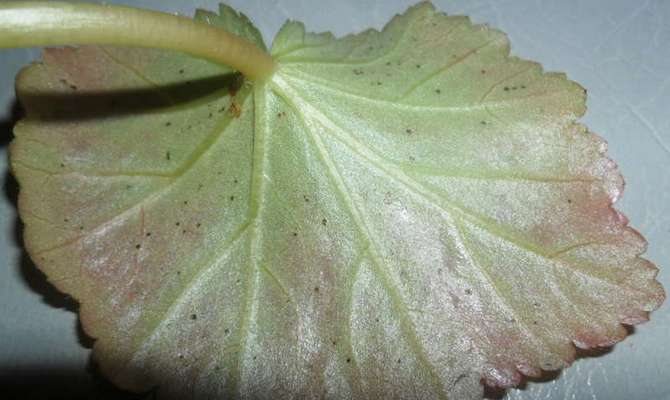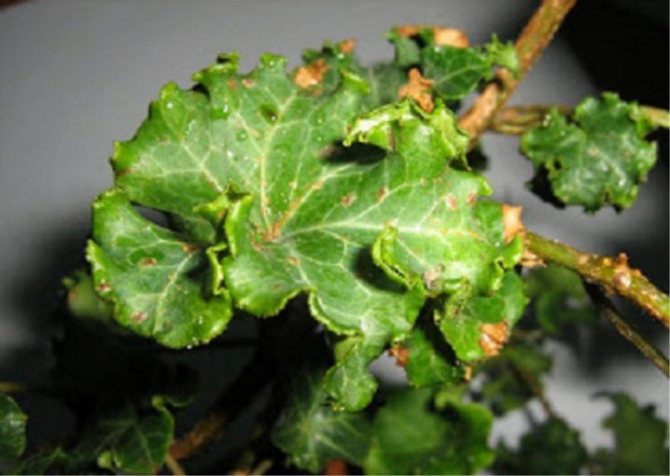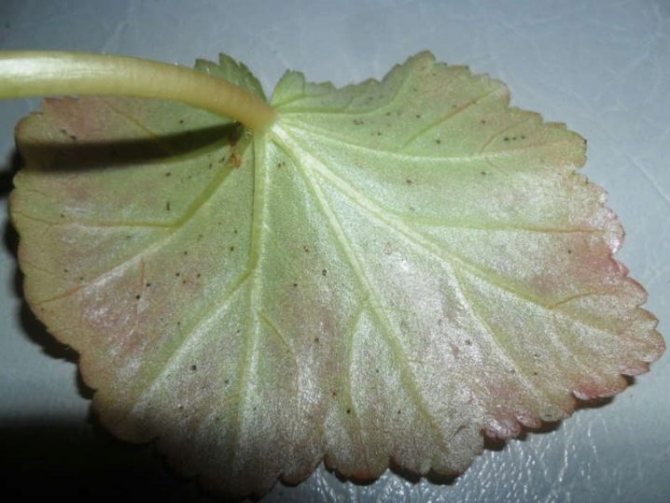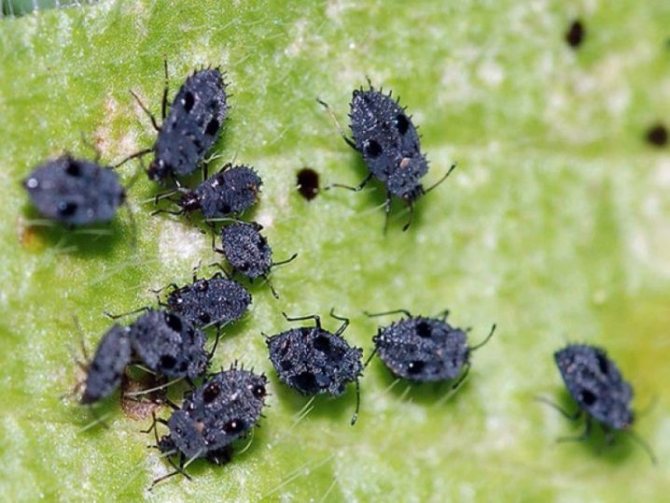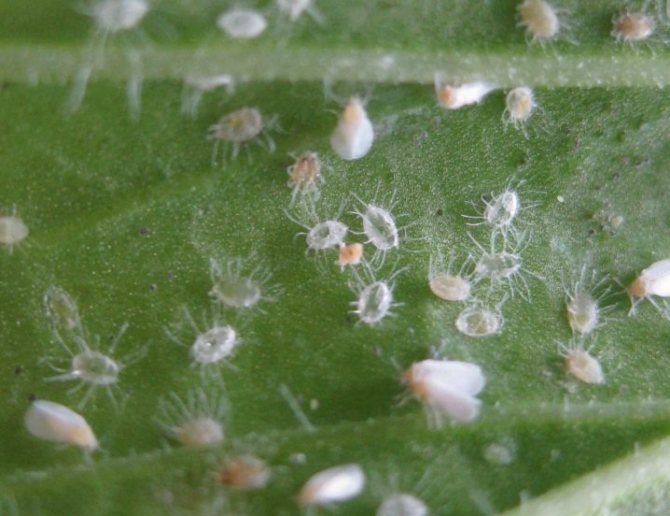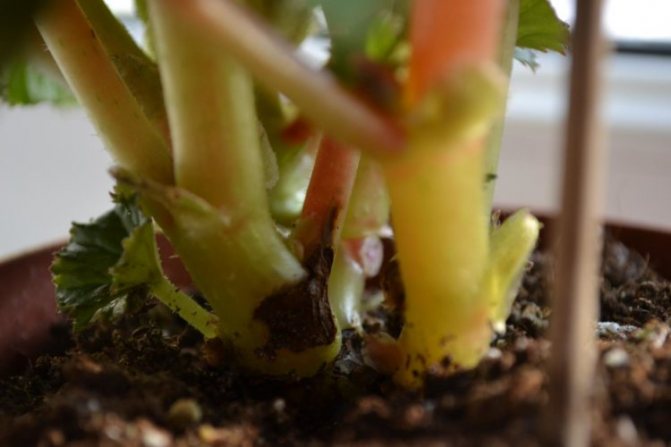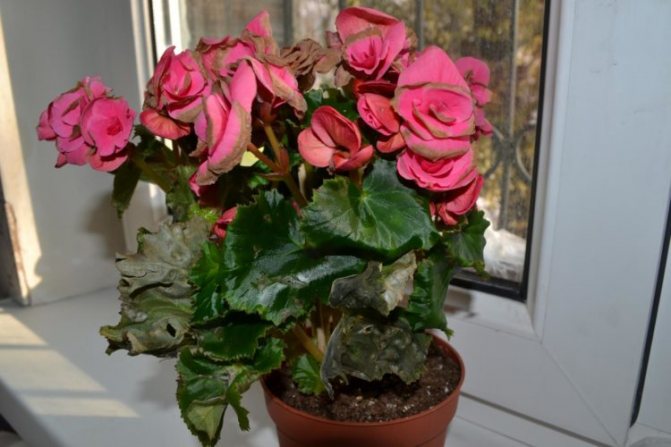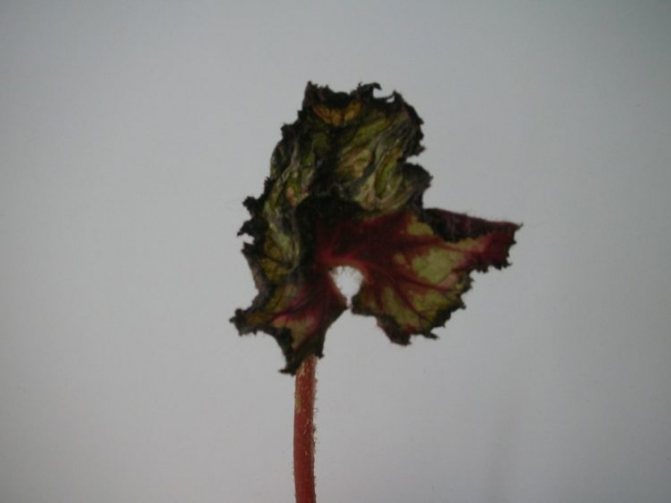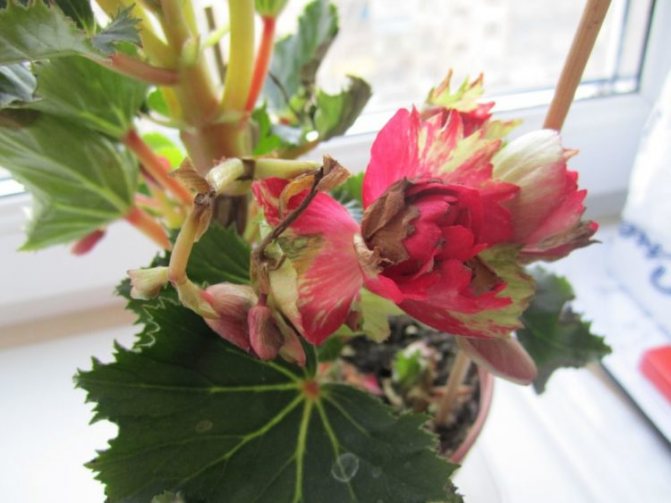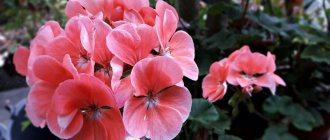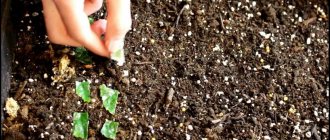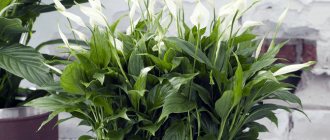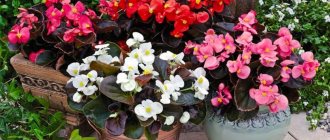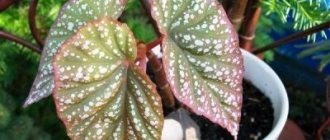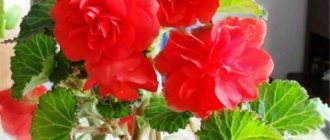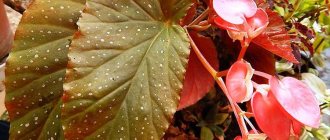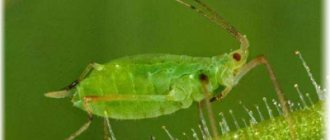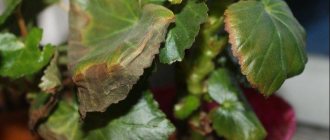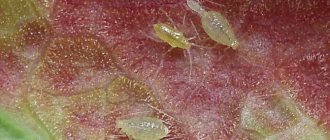Begonia is an unpretentious plant that is often grown indoors and at the same time has a positive effect on the well-being of the inhabitants of the house. When placed on a windowsill and following the conditions, the flower practically does not get sick, however the infection can be carried on clothes or shoes, or through the air from an open window. In the current article, we will consider begonia diseases and methods of their treatment with photo examples.
Infectious diseases
For a number of reasons, the immunity of a flower can weaken. At this time, he becomes vulnerable to all sorts of infections.
Powdery mildew
Due to the combination of heat and humid stagnant air, a white coating may appear on the leaves, as if the leaves were sprinkled with powder. A similar plaque on the leaves is powdery mildew, a dangerous fungal disease. If the plant is left untreated, the leaves will begin to curl, they wilt, brown sores will appear, the flowers will stop appearing, and eventually the plant will die of exhaustion.
A diseased plant must be isolated and treated with such agents as "Alirin-B", "Planriz" or "Fitosporin". If after that the plant has not got rid of the plaque or the infection has covered a large area, use "Strobin" and "Topaz". As a preventive measure, you need to provide an influx of fresh air, monitor the regularity of watering, so as not to weaken the plant's immunity. It may be necessary to reduce the amount of nitrogen fertilization.
Gray rot
Excessive humidity can provoke the appearance of gray rot: sticky brown spots appear on the leaves of the begonia, which gradually cover an increasing area, after which the leaf, and behind it, the stem, begin to rot. The diseased plant must be quarantined, all affected leaves must be cut off and the flower must be treated with Fundazol or Euparen (0.1% solution). In the future, you need to reduce watering or reduce the humidity in the room.
This disease manifests itself as small vitreous spots on the back of the leaf. Gradually, they acquire a brown tint and crawl onto stems and flowers. At the initial stage of the disease, the plant must be transferred to a room with dry air, cut off all infected areas, capturing some healthy tissue, and spray the plant with a preparation containing copper (copper sulfate, Bordeaux liquid).
With this disease, yellow-green circles appear on the leaves (the edge of the leaf is often affected), some areas die off. The spots on the leaves gradually turn dark bronze, more and more areas die off. Alas, this infection is not cured, as the tubers become infected almost immediately. The plant should be disposed of. This disease is carried by sucking insects, so it is necessary to carry out preventive spraying from them from time to time.
This disease can be detected during transplantation, when black rotten spots appear on the roots. It inhibits the development of the flower, the leaves fade as if for no reason. It is necessary to remove the infected areas, and after transplanting, spray the flower with Benomil. In the future, you should adjust the watering, do not flood the soil and do not let the water stagnate.
Vascular bacteriosis
A yellow edging appears along the edges of the leaves, gradually darkening to brown, oily spots appear on it. Leaf vessels turn black. Get rid of the affected leaves by cutting them off.Then you need to treat the begonia with fungicides.
When should you not be afraid?
In some cases, you shouldn't worry about leaves drying out. So, drying of leaves along the border can happen due to natural aging. This process takes place at the bottom of the plant where the old leaves are located. In this case, you can tear off the dry foliage or carefully cut it off with a sharp knife. The tool must be disinfected before use by wiping with alcohol.
It is advisable to sprinkle the place of cut or breakage of foliage with wood ash or activated carbon powder. Some varieties of flowering begonias shed their leaves themselves at the onset of the cold season, in order to re-grow from tubers in the spring. Such plants should properly organize the dormant period.
Important! It should be noted that the frequency of watering directly depends on the room temperature. At high temperatures in the summer heat, more abundant watering is needed - the soil should not completely dry out. If this happens, then in order to revive the plant, the pot must be soaked in water for a couple of hours.
Powdery mildew
A symptom of the disease is round brown spots on the leaves with a white coating. The affected area quickly expands to the entire leaf. The reason for the appearance of powdery mildew is too high a temperature and a low level of humidity in the room where the pot is.
If the spots have just appeared, the leaves are sprayed with Fitosporin-M or Alirin-B. In the case when the onset of the disease is missed and all leaves are affected, it is necessary to treat with Topaz or Strobin.
How to keep tuberous begonia at home in winter?
Temperature at the wintering site should not exceed 9-10 degrees. This is a prerequisite for the establishment of flower buds. Humidity at the same time increased (70-80%) is required... There are several ways to do this, depending on the conditions you have:
Basement or cellar
For this method, it is necessary to prepare a container in which the tubers will be placed. It can be a cardboard box or a wooden box. It is recommended to pour on the bottom a layer of sand, peat or sawdust.
Experienced flower growers speak well of the use of modern vermiculite material for these purposes.
Vermiculite Is a mineral powder widely used in horticulture and indoor floriculture. It does not rot or decompose under the influence of the atmosphere, so insects and bacteria do not multiply in it. The tubers placed in it will be in a certain temperature regime with sufficient air access. In addition, they will not be exposed to diseases and pests. For storing tubers, vermiculite is mixed with peat or sawdust.
On the prepared pillow, the tubers are laid out in one layer, so that they do not touch each other. From above the laid plants are covered with a layer of storage mixture. It should also cover the distance between the tubers. Each specimen should be literally surrounded by a cushion of backfill mixture.
Refrigerator
In the absence of a basement or cellar, the tubers can be stored in the refrigerator. The finished, dried material is placed in a bag, sprinkled with peat and vermiculite, or a mixture of sand and vermiculite. The package needs make holes for air access. Then the bag is placed in the refrigerator.
If you have enough space in your refrigerator, you can store the tubers in the bottom vegetable storage drawer by filling them with the peat mixture as in the previous option. It is also convenient to use food containers. Tubers are placed in them and covered with a mixture of peat and vermiculite, or sawdust and peat, just like in boxes. Make sure that the backfill mixture is completely dry, otherwise the begonias will rot or be attacked by fungus.
How to keep a tuberous begonia in a pot in an apartment in winter?
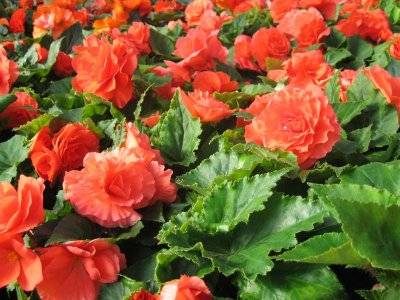
The previous storage methods are used for large, mature tubers. Young specimens are small, and will dry out with this storage. It is recommended to store them in pots with soil. Deepen the tubers in the ground, several pieces can be in one pot, and put in a dry, cool room. One or two times depending on the humidity of the ambient air. The soil with stored tubers must be moistened.
What is the reason for the drying of flowers and buds?
The most common reason why inexperienced gardeners dry out flowers is by spraying flowers directly with water. They do not experience this and immediately begin to dry up, and eventually disappear. Therefore, be careful not to let water droplets fall on the buds.
And the last reason why flowers can dry out is too frequent and abundant watering. Adjust the soil moistening mode.
It happens that not one or even a few leaves dries, but everything at once. Do not rush to say goodbye to your plant right away. Perhaps only the ground part of the flower deteriorated, but the rhizomes remained alive.
- Remove the flower from the pot and look at the roots for rot and parasites. If most of them are in good condition, remove the damaged ones, and plant the rest in new soil.
- Remove any dying leaves, buds, and stems, feed the soil, and then cover the pot with a plastic bag or plastic wrap.
- The main thing is to place the flowerpot in a suitable place - take into account the air temperature and lighting.
- Spray with Epin every seven days.
If, when studying the roots, not a single living one was found, then, unfortunately, the flower cannot be saved.
Recommendation. If possible, get rid of this soil, because pests can live there, because of which the plant died. It is better to pay and buy a new soil mixture than to destroy a young plant every time.
In this video, you will learn how to save houseplants from pests and diseases.
Diseases of begonia are directly related to improper care of the plant. This is a rather unpretentious flower, and if you follow the simple rules of watering, maintain the desired level of humidity and illumination, it will delight you with the variety of its flowering. It remains only to figure out what begonias need for good growth, and what problems a variegated plant can overcome.
Begonia needs good lighting, but without direct sunlight on the leaves. For this purpose, we recommend shading the flower.
Install blinds on the windows, cover it with a transparent cloth or gauze to avoid sunburn. This is especially true in the summer, when the sun's rays are most aggressive.
Indoor begonia
If exposure to direct sunlight is accompanied by stagnation of water droplets on the leaves, numerous holes are formed in these places, damaging the structure of the leaf plates. The pallor of the leaves and their yellowing may indicate insufficient watering or illumination. This is especially true of the Royal begonias with a multi-colored palette of colors from red to dark brown.
One of the most important points in caring for indoor flowers is the correct watering, which is individual for each plant. As for begonias, in the summer this flower requires abundant watering, without stagnation of moisture in the soil, and in the autumn and spring - moderate.
Waterlogging is unacceptable. Before watering the plant, make sure that the topsoil is at least 1-2 cm dry.In winter, tubular begonias in pots are practically not watered, but stored in a peat substrate.
Rolling the leaves of the plant
Before wintering, we remove all dried flowers and leaves, and send the flower itself to a cool place with a temperature of 10-12 degrees until spring, occasionally watering the substrate. To prevent stagnant water in the soil, select low, wide pots with drainage holes for begonias.
If there is no drainage in the tank, you can do it yourself. To do this, add vermiculite, coconut fiber, chopped pine bark to the peat substrate, or put pieces of foam and charcoal on the bottom of the pot.
In case of non-observance of the rules of watering, indoor begonia sheds leaves and buds.
The first signals of waterlogging are the darkened tips of the leaf plates, which dry out and fall off over time. With a lack of moisture, begonia leaves curl due to lack of nutrients.
To avoid such unpleasant embarrassment, use for irrigation only settled water with a low level of hardness.
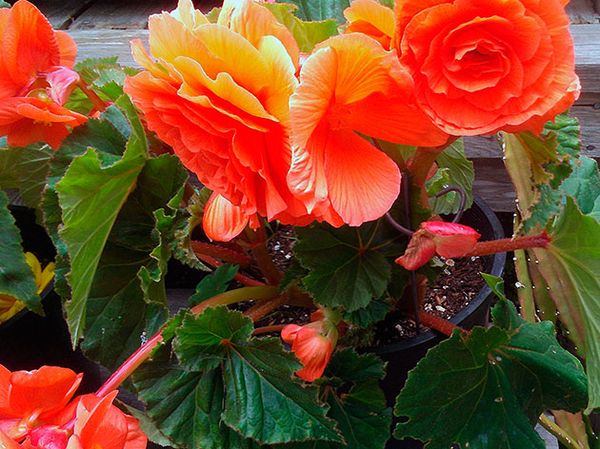

Indoor begonia also needs sufficient moisture in the air. You can achieve the required moisture by placing plants in groups. We place the most demanding crops in the center, and put moss and gravel cushions on the sides.
The optimal humidity level for begonias is 60%. In this case, the leaves should in no case be moistened or sprayed with a spray bottle.
Signs of gray rot on a plant
In case of violation of these rules and spraying with water from a spray bottle, brown spots remain on the leaf plates in places with a large accumulation of moisture.
Therefore, in hot dry weather, it is recommended to place begonias pots on a box with wet peat or moss. This method will simultaneously prevent dry air and avoid the harmful effects of moisture on the variegated plant.
Remember, dry air leads to the slow death of the plant, causing the leaves to dry out and fall off.
However, do not be too zealous with the humidity of the air, otherwise it can lead to the development of fungal diseases, in particular gray rot, the causative agent of which is the fungus Botrytis.
A characteristic feature of this disease is the formation of white wet spots covered with a gray bloom on the leaves, buds and tops of the shoots.
With further development of the infection, the stems of begonia weaken and break, the leaf plates completely blacken and dry out, and the buds and flowers become covered with mucus and stop blooming.
At the initial stage of the disease, we recommend treating begonia with a solution of 1% Bordeaux liquid or a soap-copper mixture at the rate of 20 g of laundry soap and 2 g of copper sulfate per liter of water. If, after such treatment, gray rot is still progressing, apply 1% Fundazole solution.
In advanced cases, more effective fungal fungicides, such as 0.1% BMC, 0.2% Euparen, Topsin, Rovral, or 0.4% Polycarbacin, help to save the plant.
Another fungal disease, powdery mildew, is no less dangerous for begonia. A characteristic feature of this disease is the formation of a white powdery coating on the leaves and stems of the plant.
As a rule, a disease occurs as a result of poor ventilation of the room, dripping condensation on the leaves, as well as excess moisture in the soil and air humidity.


Powdery Mildew Begonia
Depending on the cause of the occurrence, we recommend drying the soil, ventilating the room and using fungicides to fight the fungus. Before doing this, we remove all the affected areas.
Spraying begonias is carried out with 0.1% Fundazol solution or 0.05% Morestan. During the flowering period, it is better to use a 0.5% solution of colloidal sulfur for processing.
If small watery spots appear on the underside of begonia leaves, these signs indicate infection of the plant with bacterial spot. Unfortunately, it is impossible to help the flower, it is doomed to perish.
It must be destroyed along with the soil, and the pot must be disinfected with a solution of potassium permanganate or copper sulfate. For the prevention of bacterial disease at the beginning of flowering, spraying begonia with a 0.5% suspension of copper oxychloride.
We repeat the procedure twice with an interval of 14 days.
Signs of leaf spot
The appearance of yellow-green concentrated circles, which eventually turn into bronze spots with a yellow border, is a sign of a viral disease called ring spot. Unfortunately, as with bacterial spotting, begonia is doomed to die.
As a prevention of infection, spray the plant from sucking pests (thrips, aphids), which are the main carriers of the dangerous virus.
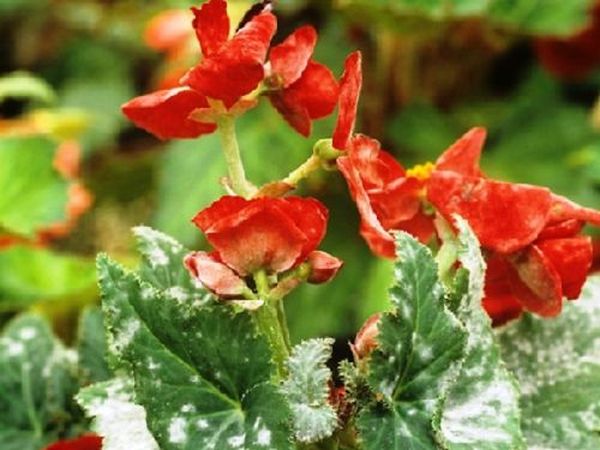

Pests significantly weaken the root system and lead to the death of begonia. Among them, spider mites and orange aphids are often found. A sign of the appearance of the first pest is the formation of yellow spots on the leaf plates, as well as a silvery coating with bronze stripes, which are especially visible in sunlight.
As a result of the harmful effect, the mite deforms and disrupts the structure of the leaves, leaving numerous spots and stripes on them, leading to massive leaf fall.
Aphids on begonia leaves
The most effective in the fight against ticks have special preparations - acaricides. Among them, the following selection can be distinguished. Natural pesticide Pyrethrum, derived from the plant. It is highly effective in the fight against spider mites, although some mites have developed resistance to the drug.
The second acaricide absolutely safe for home use is Cinnamon stone. This drug destroys only adults, not larvae. Use the drug every 3 days for two weeks. As a prophylaxis and fight against spider mites, Neem oil, obtained from the nuts of the Neem tree, is used.
If the Emerald Flower is completely dry - how to revive it?
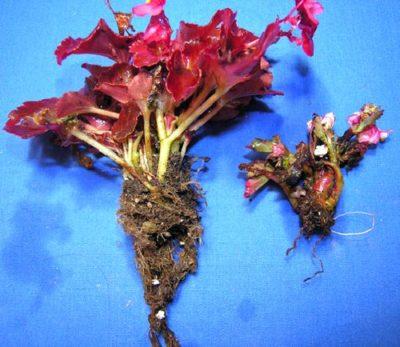

It happens that not one or even a few leaves dry, but everything at once. Do not rush to say goodbye to your plant right away. Perhaps only the ground part of the flower deteriorated, but the rhizomes remained alive.
- Remove the flower from the pot and look at the roots for rot and parasites. If most of them are in good condition, remove the damaged ones, and plant the rest in new soil.
- Remove any dying leaves, buds, and stems, feed the soil, and then cover the pot with a plastic bag or plastic wrap.
- The main thing is to place the flowerpot in a suitable place - take into account the air temperature and lighting.
- Spray with Epin every seven days.
If, when studying the roots, not a single living one was found, then, unfortunately, the flower cannot be saved.
Recommendation. If possible, get rid of this soil, because pests can live there, because of which the plant died. It is better to pay and buy a new soil mixture than to destroy a young plant every time.
What is this plant?
The plant, first found on the island of Haiti and named after the governor of this island, Michel Begon (also has other names - Emerald, Imperial). The entire family includes over one and a half thousand varieties. There are one- and perennial.
They develop to the size of shrubs and semi-shrubs. Usually, the leaf plates of this flower have an asymmetrical original shape. Their shade is always very rich, and the pattern formed thanks to the veins creates a unique effect. There are no peculiarities in the growth of Begonia.
On a note. Begonia is very easy to care for. And if all the recommendations are followed, he practically does not get sick.
But, unfortunately, everything is not always cloudless. Begonia leaves can be attacked by diseases and pests and begin to dry, or even disappear altogether.
Preventive measures
- Be sure to keep an eye on watering the plant. Waterlogging, as well as lack of moisture, can destroy the plant.
- If the indoor air is dry, then provide regular spraying or place a small container of water next to the plant.
- During the flowering period, feed the begonia with fertilizers at least three times a month.
- Inspect the flower more often for the appearance of diseases and pests in order to provide timely assistance to the plant.
dacha.expert
Other causes of the phenomenon
Why do the leaves dry at the edges of the room?
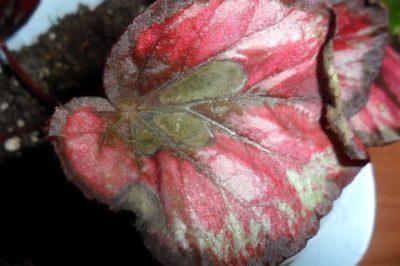

Draft. With the onset of hot days, inexperienced flower growers try to air the flower by exposing it to a loggia or near an open window, thereby placing Begonia in conditions that are unacceptable for it.- The sun. Given the fact that we have a tropical plant in our hands, we try to give it as much light as possible and put it in the most illuminated place in the house. But in return we get burnt and drying leaves. The reason for this phenomenon was the direct rays of the sun.
- Dry air. Usually this factor arises in the winter due to the fact that heating devices begin to work, which very dry the air. Read about the proper care of begonia in winter here.
- Lack of fertilizer. Or an incorrectly selected complex of nutrients.
- Attacks by pests and diseases.
- Stress. A flower is also a living being. And therefore, he can react to a careless attitude towards him or a sharp change in growth conditions.
- Water composition. When leaf wilting begins with the appearance of brown pigmentation on them, we can safely say that the reason is in the chemical composition of the irrigation fluid. You can read about how and what to water this plant here.
- Too warm and dry weather.
- Lack of irrigation.
- Lack of weeding of beds.
Well, and, perhaps, the last possible reason for the drying of begonia leaves is improper feeding. First of all, it should be remembered that this plant is used to growing only in an ideal environment for itself. Therefore, every begonia owner is obliged to pay attention not only to the conditions of its cultivation, but also to the quality of the substrate and its mechanical composition.
Professionals say that before planting begonias, you need to choose the most suitable soil for it. As a rule, this is a loamy soil with a sufficient amount of trace elements and minerals.
As numerous studies have shown, begonia needs 3 feeding per month. The most suitable fertilizer in this case is liquid solutions with a minimum nitrogen content, since it has a detrimental effect on the further growth and development of the plant. Plus, potassium nitrate is suitable for feeding. If it is not possible to carry out such fertilization, it is better not to do this at all, since other analogs can negatively affect the further life of the plant.
Begonia is a rather picky plant that requires proper care and conditions. If this is not provided to this plant, the flower will gradually begin to die. But if you follow all the recommendations of experts, begonia will delight you for a long time.
Pests and their destruction
There are two methods of pest control - mechanical and chemical. In the first case, if the pests are large and there are not too many of them, you need to collect them by hand. It can be a scale insect, a worm, a slug. Chemical processing involves the use of preparations, decoctions, juices and infusions of such plants: lemon, tangerine, orange, black pepper, potatoes, tomato tops, garlic, onions, agave leaves, tobacco. The primary goal of the second method is prevention. Use only herbal preparations if begonias are grown indoors. To prepare medicinal herbs for the further manufacture of decoctions and infusions to prevent the appearance of pests, the herbs must be dried in a dark place in a draft, then the raw materials must be crushed and removed to a dry place.When making broths, additionally use surfactants, such as laundry soap, liquid and potassium soaps.
What pests can infect begonia?
Greenhouse aphid
The greenhouse aphid can be yellow or green, reaches 2.5 mm in length, does not have wings. The mouth organ is piercing-sucking, both adults and larvae are harmful. Due to the suction of the juice, the leaves turn yellow, the buds do not bloom, the flowers fall off. This type of insect is more often concentrated on the back of the leaves. They pollute the plant very much, giving off sugary excrement. They breed in greenhouses all year round, the larva develops to an adult in a week, one female breeds up to 100 larvae in one offspring. Aphids die if the air temperature drops to 0 ° C. The increased air temperature and a sharp drop in humidity in June also contribute to a decrease in the number of insects.
At home, spray begonia with a 2-4% solution of green or laundry soap or tobacco infusion. To prepare tobacco infusion, soak 100 g of makhorka in a liter of warm water for 2 days, then strain the infusion and dilute with water 2-2.5 times. In a greenhouse, it is necessary to use a 0.4% soap solution and a 0.15% benzophosphate solution. No less effective is 0.1% actelik, 0.1% benzophosphate, 0.05-0.1% cronetone solution or 0.05% selecron.
Soft shield
This insect is larger than aphids and reaches 4 mm in length. The female does not move, is covered with yellow-brown waxy shields, has piercing-sucking mouth organs. The larvae are mobile, but after attaching to the plant, they lose this ability. The most common habitats are leaves, stems, petioles, begonia veins. The plant rapidly loses color and deforms as soon as these pests infest it. The first sign of a false shield habitat on a plant is the presence of sugary secretions with a dark bloom and sooty fungi. The female reproduces 3-4 generations of larvae per year.
Use a mechanical method to clean the plant in your garden or at home. For this, a soft brush and a garlic infusion or an infusion of pyrethrum (10 g per liter of water in both cases) are suitable. It is necessary to process the plant after infection every 2-3 weeks. For greenhouse cultivation, spraying from April to September with the following solutions is suitable: 0.1% hostaquik, 0.2% chlorophos or 0.1% actelik.
Greenhouse thrips
The insect reaches 1.5 mm in length, has piercing-sucking mouth organs, two pairs of wings. Affecting begonia, thrips discolor it, deforms it, stops growth and promotes strong yellowing of the leaves. Females lay eggs in the epidermis of the leaves; wintering takes place on the tubers of plants on the upper layer of the soil. The adult has a dark brown color, the larva is light, bright orange. In a month, the larva develops to an adult, especially at a temperature of 30 degrees and 85% of air humidity.
Use 100 g of infusion or decoction of tobacco or celandine per liter of water for spraying begonias in the garden or at home. Washing the plant with soapy water is no less effective. For prevention, before planting, treat the tubers with karbofos (20 g per 10 l of water). For greenhouse cultivation, pollination with pyrethrum or spraying with a solution of benzophosphate 0.1%, methylpitrophos 0.1-0.2%, hostaquik 0.1-0.15% is suitable. Treatments are carried out once a week if the plant is already infected.
Greenhouse whitefly
The yellowish insect with large white wings reaches 1.5 mm in length, more often it affects greenhouse begonias, but in the open field they are also found in summer. It is the leaves of the plant that are most affected, visually this is displayed by the loss of color. The female lives up to 30 days, but manages to lay 500 eggs on the back wall of the leaves. The larvae appear after 10 days, the insect carries viral diseases.
For home care of the plant, it is enough to use a soapy solution for spraying (40 g of soap per 10 liters of water). For greenhouse cultivation, an emulsion of triphos 0.5% or a solution of rovikurt 0.05% and actelik 0.1% is relevant. Effective in the fight against this pest are Ashersonia fungi and the Enkarsi parasite.
Leaf and root nematode
Worms 1 mm long, attacking leaves, shoots and buds of begonias. Visually, light green spots on the foliage indicate the presence of a pest; over time, they become brown. The tops of the shoots are deformed and over time the plant dies. The most favorable conditions for the spread of nematodes are warm and rainy weather, as well as light soils. If the plant is not too affected, a 0.05-0.2% heterophos solution can be used. With extensive lesions, the destruction of the plant is the only way out.
Gall nematode is similar in size to the leaf nematode, but parasitizes mainly on the roots and in the lower part of the stems. The presence of a worm is indicated by swelling on the stems and roots, as well as growths where the larvae develop. Over time, the growths rupture, larvae emerge from there and attack the remaining roots, resulting in rotting. If you do not take any measures in time, the plant will die. The fight against rootworm nematode involves the removal of the affected roots and stems of the plant, as well as watering with a solution of heterophos 0.05-0.2% under the root (1 liter of solution per 1 m2). Preventive measures consist of thorough decontamination of the soil with steam or 1% thiazone or formalin solution.
Description of the main diseases of begonia and methods of their treatment
With the timely detection of damage, begonia can be reanimated with the help of special drugs. However, there are diseases, the presence of which makes begonias a fatal diagnosis:
- Ring spot. It is transmitted by pests and is characterized by the appearance of yellow spots and dead areas on the leaves.
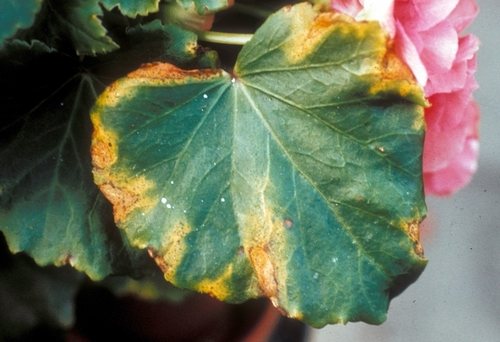

- Bacterial spotting. On the back of the leaf, watery small spots appear, which darken over time and completely affect the entire flower, including the inflorescences.
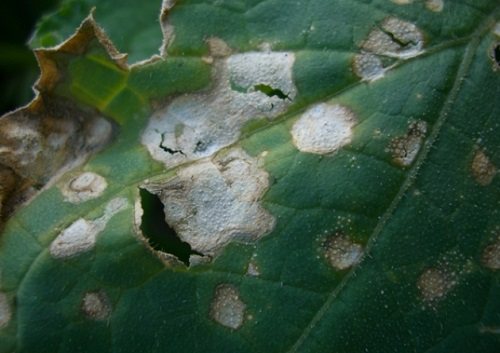

- Leaf nematode. The edge of the leaf first fades, retaining its green color, and then gradually dries out. A completely dry leaf is covered with brown spots. The disease is transmitted to the flower through the soil as a result of low temperatures and high humidity.
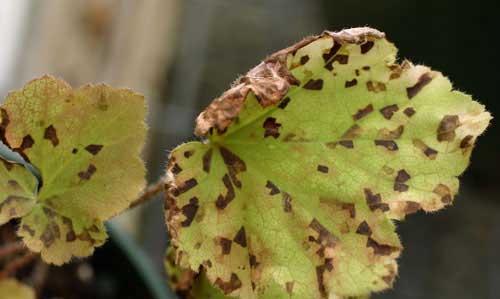

In these cases, begonia must be destroyed immediately so that the disease does not spread to other plants.
With proper care, begonias rarely get sick, especially if they are grown at home on a windowsill, but we can bring pests or infections into the house on shoes or clothes.
Next, we will look at what diseases of begonias are most common, how to process the plant and how to deal with pests.
It is most dangerous to keep begonias on the balcony, since an open room gives free access to infections and pests.
In addition to preventive measures, you need to know about pest control methods or how to treat a plant if it gets sick.
Leaf diseases
Begonia leaves
During the growth and flowering of tuberous and ornamental begonias, such problems can occur.
- If the leaves are covered with brown spots and gray bloom, it is necessary to cut off the affected areas and treat the begonia with a fungicide. Observe the ventilation mode, prevent overmoistening of the air. Do not place the plant in an area that is too dark.
- Leaves can turn yellow due to lack of light and over or under watering.
- Lack of light can also contribute to leaf fall.
- Heat makes them crooked and dry, and excess moisture causes them to rot and wilt.
- If the leaves have brown tips, the humidity is too low, spray the air around the flower or place a container of water next to it.You do not need to spray the begonia itself, otherwise rot and brown spots will form on the leaves.
- If the leaves rot and have a pale color, excess watering.
- Dry air contributes to the fall of not only leaves, but also flowers and buds. Drafts, sudden temperature fluctuations, excessive watering can also be the reason.
- Leaf diseases can lead to the complete death of the plant if no measures are taken in time. If the plant has died, it is worth considering several reasons - defeat by a weevil, if tubers are eaten, damage by nematodes, if there are swellings on the roots, as well as root rot due to excessive watering.
Powdery mildew
A diseased plant must be isolated and treated with such agents as "Alirin-B", "Planriz" or "Fitosporin".
If after that the plant has not got rid of the plaque or the infection has covered a large area, use "Strobin" and "Topaz".
As a preventive measure, you need to provide an influx of fresh air, monitor the regularity of watering, so as not to weaken the plant's immunity. It may be necessary to reduce the amount of nitrogen fertilization.
Gray rot
Care rules
Failure to comply with plant conditions adversely affects its development and appearance. There are the following signs and reasons for the deterioration of the state of begonia associated with improper care:
- The formation of brown spots and gray plaque on the leaves - the cause of the disease is insufficient ventilation of the room, excessive watering. The location of the flower at a distance from the light source is not excluded.
- Yellow leaves - the plant does not have enough sun, violation of the soil moisture regime.
- Falling foliage - little sun.
- Leaves dry and curl - it's too hot in the room.
- The green cover withers and rots - excessive watering, there is no drainage layer in the pot and holes to remove excess moisture.
- The tips turn brown - dry air in the room.
- The leaves turn white, signs of rotting appear - excess moisture in the pot.
- During flowering, buds and leaves fall - the plant is in a draft, excessive moisture, a sharp change in air temperature.
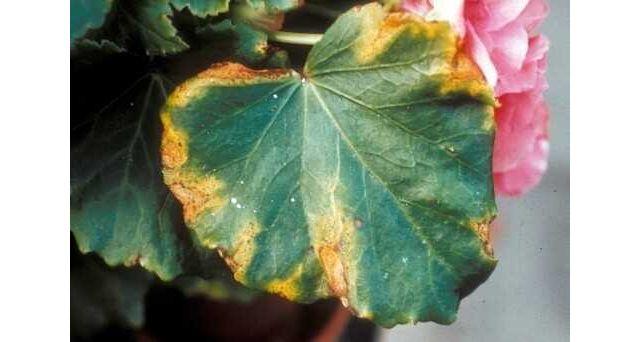

In the event that all the rules for keeping the plant are followed, you should dig deeper - perhaps a pest has settled on the begonias or an infection with a certain disease has occurred. Let's take a closer look at this issue.
How to stop?
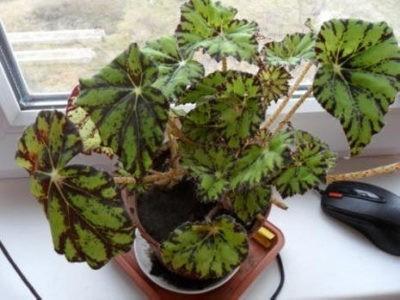

If your plant is standing in a draft, immediately change its location for it.- In the hours of maximum activity of the sun's rays, create shade or partial shade for Begonia. Alternatively, move it to a permanent location on the east or west side of the room.
- Humidify the air. But we do not recommend doing this by spraying. It will be better if you put a container of water near the flowerpot. It is also advised to periodically put a pallet with expanded clay under the pot. Sometimes you can get by with a simple rearrangement of the plant away from the radiators that dry the air.
- Lack of nutrients can be the root of the problem of leaf drying, especially during the period of active growth and flowering of Begonia. Therefore, do not forget to pamper your beauty every ten days. To do this, use complex liquid fertilizers purchased in special stores. Pay attention to the composition of the fertilizer. The percentage of nitrogen in it should be minimal, as it is not suitable for flowering plants. Read about how to feed begonias for abundant flowering here.
- We will talk about possible diseases and pests separately below.
- Stress for a flower can be a change in temperature, watering regime, lighting, transplanting into a pot that is too large (read here how to choose a flowerpot for begonia and properly care for it in a pot). Even completely harmless pinching off a sprout can lead to stress. Of course, begonias need to be pruned periodically, and some reproduce only by cuttings. But here it is important to know where to “bite off the tidbit”.
- Water for irrigation must be prepared. If you take from the central water supply, let it stand for a day. Better yet, use rainwater to moisten the soil.
Attention! Filtered is not recommended to use, since after filtration, not only harmful, but also useful elements disappear. - Water and humidify your garden crops more often as described above. Read about proper care and reproduction of garden begonia here.
- Remember to remove weeds that clog the plant and prevent it from developing.
How to transplant store-bought flowering begonia
If begonia was purchased in the store, transplanting after purchase is desirable, but do not rush - let the plant adapt and start transplanting in a couple of weeks or a month later, and if the plant is blooming, let it finish flowering.
It is best to transplant the begonia into a breathable pot - ceramic or clay, since in a plastic one there is more chance of root rot, the bottom should be with holes, since drainage for begonias is a prerequisite, it can be large expanded clay, pieces of brick or shards, pour a layer on top coal.
The soil for begonia can be bought ready-made, but it is easy to prepare it yourself - half it consists of leaf humus, the rest of the parts - peat and sand. It turns out a loose and nutritious substrate.
Remove an earthen lump from the old pot, inspect the roots of the begonia, remove dead, dried out areas - if decay is noticeable, the root system should be washed with a solution of pale pink potassium permanganate. Dry the cut points and sprinkle with charcoal powder, then lower the begonia roots into the prepared soil - at least a centimeter should remain to the edge of the pot so that you can pour enough water. Water the begonia well after planting.
What to do for prevention?
Any especially new advice on preventing leaf drying has not appeared over the past decades, probably. Everything is as old as the world. Just follow the optimal growing conditions for Begonia:
- the place is bright, but without direct sunlight;
- regular watering with water without chemical impurities;
- inadmissibility of drafts;
- optimal temperature regime (18-2 degrees Celsius);
- a well-chosen complex of fertilizers.
Note! If the lowest leaves of Begonias begin to dry out, there is no need to worry at all. This is a natural process of withering away old leaves of a plant.
You need to start sounding the alarm only when this unpleasant phenomenon becomes widespread. Just pinch off the wilting leaves, and then the young foliage will receive more nutrients and it will become more oily and saturated.
Helpful hints
Professional florists give the following useful tips for keeping begonias:
- For irrigation, take well-settled or filtered water at room temperature. For softness, it can be acidified. In cold weather, watering is done with warm water and only when the soil is dry.
- It is advisable to periodically loosen the soil by about 1 cm in depth in order to improve the flow of oxygen.
- The room should be regularly ventilated for fresh air, but without drafts for plants.
- Deciduous begonias should properly organize a dormant period in the fall.
- A pot with begonias should be placed on a well-lit side, but without direct sunlight, which can cause burns.
- Provide the required level of humidity. To do this, carry out small spraying with a spray bottle. It should be noted that they spray the air near the begonias so that moisture does not get on the leaves - this can cause brown spots. It is recommended to put a container of water near the flowerpot near the flowerpot or put the pot in a tray with wet pebbles to maintain humidity when the room is dry.
- Regularly feed the growing plant.
- When replanting, use loose nutrient soil with a pH of 5.5–6.5. You can buy ready-made soil for begonias, or you can make a soil mixture based on leafy earth, peat, sand and humus.
- Watering should be carried out in moderation so that the water does not stagnate in the pot, as this leads to the appearance of many fungal diseases. It is recommended to water at the same time in the morning. During the period of ovary and flowering, the plant should be watered more abundantly.
Learn more about the peculiarities of growing such types of begonias as: coral, mason, elatior, ever-flowering, royal, cleopatra, red-leaved, tiger.
To organize such care of begonia so that its leaves do not wither, even for a beginner. You should spend quite a bit of time, and your plant will delight you with its flowering appearance.
Interesting Facts
- Begonia tubers are edible and have a citrusy flavor.
- This flower is a state symbol in North Korea - it can even be seen on the flag of this country.
- The seeds of the plant beat all world records for their size. From a bag weighing 30 grams, you can get about 3,000,000 sprouts.
- In ancient times, Begonias were used to polish sword blades.
- One of the main beneficial properties of a flower is the ability to purify the air and improve immunity. Therefore, Begonia is often placed in rooms where children are. especially allergy sufferers.
All about whether it is possible to keep begonia in the house, we wrote in this article, and about the useful and harmful properties of this plant for the house and for humans, read here.
I hope, after reading this article, you are finally convinced that the described plant is ideal for novice florists and busy people. After all, caring for the Imperial Flower does not take much time and is not difficult. So go for it!
Secrets of preparing for winter storage
Proper storage of tuberous begonias in winter - necessary condition... If they are not followed, the tubers will form a small number of buds and flowering will be poor.
First of all, you must observe extraction time from soil... If you are late, waiting for the first frost, he may suffer. The tubers of this flower do not tolerate even short-term freezing. But you can't dig them out earlier either. As soon as the foliage begins to dry out, the flower begins an active set of tuber mass and buds for the next flowering. Therefore, early extraction from the ground will reduce the number of flowers during the growing season.
Watch closely for the condition of the aboveground part. As soon as all the foliage turns yellow and falls off, it's time to act. Do not use a large shovel you can damage the delicate roots with it. Cut off loose stems carefully with garden shears or pruning shears.
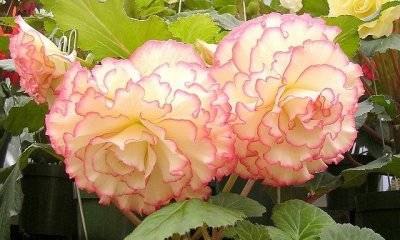

After digging out of the ground, carefully peel the tubers. Air dry them indoors with warm, dry air. If there is high humidity in the room, rotting processes may begin in the tubers. In preparation for winter, the tubers ripen, this process
lasts 15-20 days.
Sometimes unexpected autumn frosts occur, and the leaves of the plant immediately freeze. It is a mistake to believe that the root part is also frozen. Most often, with short-term frosts, the underground part remains unharmed. Dig up such copies and try to keep them.
Why leaves can dry
Begonia is a beautiful flower that pleases lovers with a riot of colors. This plant has many types and is grown both in the apartment, as an indoor plant, and in the garden. Few people know that for the amazing shape of the leaves, begonia is called the elephant's or bear's ear.
Like any plant, begonia requires attention, care, love and proper care. Often, flower growers cannot solve the problems that arise in the process of growing a flower on their own.The bush is naughty, withers, does not want to grow, the leaves curl, dry around the edge and fall off, the flowers turn black.
Let's try to figure out why this is happening.
- The plant finds itself in an unfamiliar environment. For example, with the onset of spring, windows and windows are opened in apartments, a draft arises in the apartment, which begonia does not like very much. Or, knowing that begonia is light-loving, they put it on the balcony, wanting to please with the sun and warmth. And they achieve the opposite result.
A plant that has received stress begins to rebel, the leaves dry up and wither. Solution: Return the flower pot to its usual conditions - on a lighted warm windowsill. - If the leaves dry and turn yellow in winter, then the begonia's love for a humid environment is to blame.
Usually in room conditions they are grown on window sills, under which are located steam heating radiators. The air in the apartment is dry. Solution: Place the flower pot in a different place. If this is not possible, you can place a cup of water next to it. Regular spraying with water will also help.We moisten the air by spraying, trying not to get on the plant, especially on the buds.
- Lack of micronutrients. Solution: Pamper with regular fertilizing with complex fertilizers. Or use potassium nitrate.
When choosing a complex fertilizer, pay attention to the nitrogen content. It should be as small as possible.
- Hot and dry weather, insufficient irrigation What to do: Adjust the water supply. But there is a small nuance here. The roots do not like constant dampness, so you need to make sure that the earth is moist, but well ventilated and not constantly wet.
For the prevention of any disease, you need to adhere to several rules:
- Plant pots should be farther apart.
- The place for begonias should be bright, sunny, warm and free of drafts.
- The air around the begonias should be humid.
- Observe the watering regime. The ground should always be slightly damp, but not wet.
- Timely feeding.
Bacterial spot of begonia Powdery mildew Gray mold Ring spot
- Gray rot. Symptoms: Gray watery spots appear on the leaves. Flowers and stems gradually become slippery and slimy, the leaves dry up and begin to fall off. The reason is excessive moisture.
Treatment: Spray with a 1% Bordeaux mixture or a copper-soap solution (a little tar soap, 20 g of copper per liter of water). Treat with benomyl. - Powdery mildew - white bloom Symptoms: spots with white bloom appear on the leaves. If you do not take action, they increase in size and gradually cover the entire leaf completely, gradually the leaves turn brown, curl and dry out.
Treatment: Spray the plant with either 0.05% morestan or 0.05-0.1% foundation. For prophylaxis, spraying with a soap-copper liquid or a solution of colloidal sulfur is suitable. - Ring spot Symptoms: Yellow-green spots or concentric lines appear on the leaves, they grow and turn into bronze spots. The cause is the so-called tomato virus carried by sucking insects such as thrips or aphids.
Prevention: Watch out for pests.Treatment: it is better to destroy the flower, since the treatment does not give results.
- Bacterial spot - brown spots Symptoms: small glassy watery spots form on the underside of the leaf. Gradually, they turn brown and capture the stems and buds.
Prevention: Spray every two weeks with 0.5% copper oxychloride solution.Treatment: It is not subject to treatment, the flower must be destroyed so as not to spread the infection, the pot must be thoroughly disinfected, it is better to discard the earth and replace it with another.
Begonia flowers turn black
Cause:
- Water gets on the flowers during watering. Solution: water at the root, avoiding droplets on the buds and on the edges of the leaves.
- Lack of moisture for foliage and flowers, for example, in hot and dry summers or in winter on a warm windowsill. Solution: Place a flowerpot with a flower on wet expanded clay.
- Using a spray, humidify the air around the plant, being careful not to get water on the buds.
There are two types of begonias - root begonia and tuberous begonia.
For both species, root wilt occurs due to over-watering. If water stagnates in the ground, and the roots and tubers begin to rot, the plant withers, the leaves fall off, in this case it is necessary to limit the amount of moisture supplied.
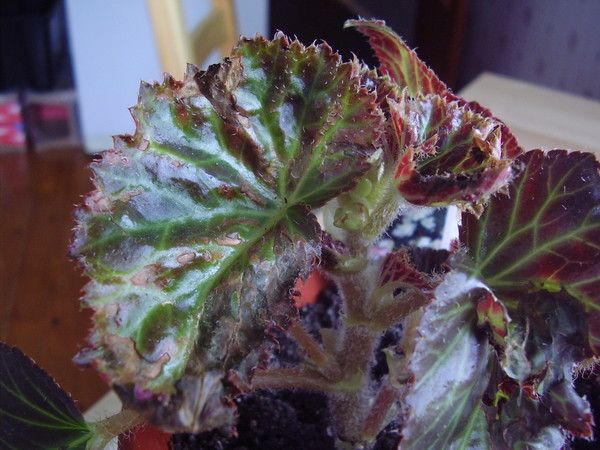

The second reason is the infestation of the flower with nematodes. Since this is a viral disease, the plant dies.
You just need to cut off all the leaves, stems and flowers, and place the tubers in a closed container with dry sand or soil and store in a cellar or on a loggia at temperatures from plus five to plus ten degrees.
Flower withers due to over-watering Nematodes Pruning for winter
Buds fall
Begonia is a very capricious plant. Buds can fall off for a variety of reasons:
- Insufficient watering.
- Excessive watering.
- Dry air around the plant.
- Water got on the buds.
- Excessive feeding.
- Insufficient feeding.
- Move the flower pot from place to place. Even turning a few degrees can cause the buds to fall off.
Solution: Observing the plant, identify the cause, adjust watering and feeding. Do not under any circumstances change the location of the flower. There may be no flowers at all if you unknowingly acquired a plant that does not bloom.
Begonia buds fall
Stem decay
The reason is, again, improper watering. Excessive moisture and getting it on the outlet provokes stem rot.
It is necessary to cut off the stem, remove the decayed part and place the stem for several days in water with the preparation "Kornevin".
There are two ways to deal with pests. Large pests - slugs, caterpillars - are harvested by hand. Small ones are sprayed with insecticides or infusions and decoctions of medicinal herbs.
Leaf nematode
These are worms up to 1 mm in size. When begonia is damaged by a nematode, light green spots appear on the leaves, the tops develop incorrectly, and the plant gradually dies. For prophylaxis, a solution of heterophos (0.005)% is used. If the lesion is extensive, the plant cannot be saved, it is better to destroy it.
Begonia: leaf diseases, photos, how to treat.
The main wealth of the group of leafy begonias is the pubescent leaves that appear immediately from the root. They can be not only green, but also red, yellow, white, silver and even brown, have a variety of shapes, edging and multicolored spots. Disease can irreparably destroy this splendor.
Spots and yellow rings on the leaves
Such manifestations begonia disease and the subsequent deformation of the leaf plates speak of the cucumber mosaic virus, against which there is no way to fight. It remains to eliminate the diseased plant as quickly as possible in order to prevent the further spread of the infection.
Gray mold
It is also called gray rot. At first, the leaves are covered with weeping white spots with a gray bloom. Subsequently, the leaf blades take on a black color and dry out. The reason for this begonia disease is the fungus Botrytis, the appearance and reproduction of which is facilitated by dampness, from which you should urgently get rid of. The affected areas of the plant will have to be removed. When the disease is just beginning, you can try to limit yourself to the treatment with Bordeaux liquid (1 percent solution) or an aqueous mixture (1 l) of laundry soap (20 g) and copper sulfate (2 g). If the result is negative, Fundazol and stronger antifungal fungicides are used - Topsin, Euparen, Polycarbacin, BMK, Rovral.
Can you help us meet spring?
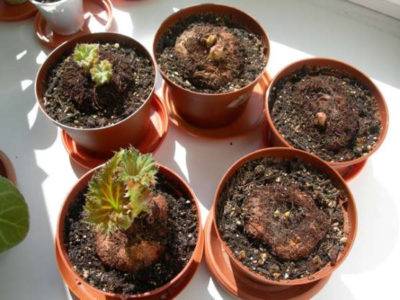

In March or early April, the home-grown plant begins to wake up, so during this period of time it can already be moved to a cool windowsill, where it will get used to bright lighting, while avoiding northern windowsills.
After a few days, you can start increasing the amount of water while watering. It must be at room temperature, settled. At this time, while the begonia gets used to the new conditions, its tuber will begin to germinate, and it will gradually begin to bloom. This is all you need to do to help the flower wake up if it has wintered in a pot. How to properly grow, water and care for begonia so that it blooms longer, we told here.
If in winter the tuber of the plant was stored in soil or sand, it must be planted for germination.: planting in containers with a damp substrate according to the 5x5 scheme, or immediately in individual pots (how to choose a pot and plant a begonia, read here). Boxes or pots where tubers germinate should be watered moderately, and also placed in a room with a temperature of 16-17 degrees.
It is best to time the tubers to sprout by the time the spring frost is due to end.
During the dormant period, begonia does not require absolutely no attention at all., therefore, it is very easy to make it so that next year it will delight you with its bright and graceful colors. And it doesn't matter who is doing it: a beginner in this business or an experienced gardener.
Good evening. Please tell me if it is possible to save begonia. In my absence, they forgot to water. Yesterday I arrived watered, the flower has thrown off almost all the leaves and stalk, today the last leaf fell off. there was a stump and roots. How can you save her? or is it all? help with nothing? Love, send a photo. But do not rush to throw it away, there may still be side shoots. Do not overmoisten the substrate, keep it evenly slightly damp.
Hello! Please tell me.
Five days ago I bought a begonia, today I watered it for the first time (as I was told, water it after the soil has completely dried to the bottom of the pot). She stood on my windowsill, about + 15 degrees. Immediately after I brought it home and pulled it out of the packaging bag, several leaves were broken, so on the third day that the broken leaves began to wither and dry out, I was not alarmed, but in some places I noticed strange spots on them, as if traces after getting water, but I definitely did not pour water on them. Then the flowers began to wither, I thought it was completely logical, and the flowers die off naturally. However, I thought that the petals should dry, but they just wither, become soft. As I said, it is standing by the beckoning on the windowsill, the windows face the north-west, so there is very little sun, and in winter it does not exceed three hours a day at all. Maybe the reason is a lack of light? I, of course, know that begonias need "bright diffused light" - a stupid question - but what does "bright diffused light" mean?)))
In general, now she looks rather sad (well, or it just seems to me), in the store she looked completely different. Please tell me what's wrong with her!
And besides, during the photo session, two completely new flowers fell away, maybe I just touched them while taking a photo ... ... in order to check this assumption, I pulled a few more flowers, but they hold on tightly.
Thanks in advance =)
Margarita, begonia, of course, should not be waterlogged, but it is also not worth drying to the bottom of the pot. It is necessary to water regularly, a little at a time, so that the soil is always slightly damp, not dry and not damp. It will rot quickly in wet soil, but dry out in dry soil. Watering is about the same as a violet and, in general, the care is about the same. +15 is not enough, it should be warmer, this is already stress. Remove diseased leaves, this is a fungal disease. Water in the form of condensation gets on the leaves during transportation and standing in the store in bags.It is advisable to spray with foundation or oxychrome. Light is also needed like violets, not a southern window, but a little with the sun, east or west, but maybe in the north, it will bloom a little more modestly. If the flowers begin to fall now, do not worry too much, this happens with begonias from transportation. The main thing is that the leaves and stems are healthy, they should be of an even pink color, without brownishness near the ground.
Natalia, thank you so much! I didn't even expect it to be so fast! Your forum is a godsend! So many useful things.
The stems seem to be normal. We will reanimate.
Thanks again !!!! =)
Hello!
Gave Begonia Beautiful flowering, looked after, but gradually the leaves began to dry out and fall off, and the flowers too.
Help save. I am attaching a photo.
Alina, all attention to the stems so that they do not turn brown at the bottom. Watering is moderate, the soil is slightly damp, do not bring it to constant dampness, otherwise rot will go. Warmth and bright diffused light. Like a violet. Flowers usually fall from a change in conditions, that's okay. The leaves grown in the greenhouse behave this way, dry out. But if the stems are healthy, then new leaves grow, already adapted to the conditions. Thank you very much. Can you spray the flower itself with a spray bottle? or will it be superfluous? I am advised to transplant it. I am afraid. That will get worse, so I don’t know if it is necessary? Alina, begonias do not particularly like spraying on the leaves, it is better next to the plant. And there is no special need for transplanting, this soil is quite suitable for begonias, transplant exactly in the same one, only injure it still. The problems are not because of the small pot, but in the difference in conditions and transportation. Thank you! helped a lot
Growth features during wintering
From early November to late February, begonia is dormant.: at this time, she is gaining strength after the active growing season, i.e. flowering and active development. How this plant "overwinters" will determine its further growth, so it is important to provide all the conditions necessary for this: significantly reduce watering, stop fertilizing begonia, greatly reduce illumination - all that will be discussed below.
If during the dormant period any of the conditions are not met, then there is a high probability that it will not bloom when the time comes for this, because it simply cannot replenish all reserves and gain strength.
Bacterial spot
Small glass-like wet spots appear on the back of the leaf plates. Later they begin to turn brown and move to cuttings, plant flowers.
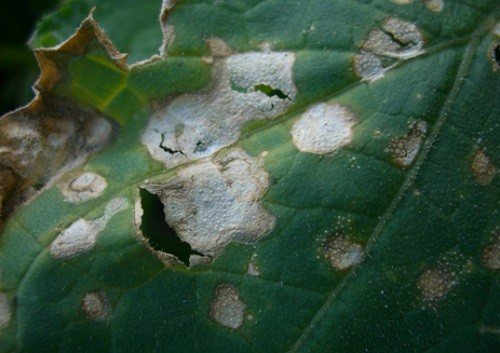

The affected plant is removed, and the soil is thoroughly disinfected. As a prevention of this dangerous ailment, it is recommended to irrigate begonia with a suspension of copper oxychloride every 2-3 weeks.
Wintering of first-year begonias
The storage of seed-derived first years is different because their dormancy period is relative. The above-ground part of them does not die off in the fall, and they should spend the winter in pots.
Since the leaves of small tubers are preserved, they need light. But the temperature of the content should not exceed 15 degrees. Water the first year sparingly to avoid decay.
Inexperienced growers mistakenly treat young nodules in the same way as with large, mature ones. But this cannot be done, because the first years grown from seeds continue to grow in the winter. If stored incorrectly, then they will dry out.
Top dressing
If it is noticed that new leaves do not grow, and remain small or begin to dry, this indicates that the flower is not nourished enough. Top dressing should be added and liquid fertilizers are the best option. A transplant will help achieve a similar effect.
Top dressing should be applied in winter and during the period when begonias are preparing to bloom. Fertilizer can be purchased at specialized stores.
In this case, you need to take into account the variety of begonia.Ornamental deciduous plants require nitrogen, so Agricol and Kemir are suitable for them. Decorative flowering plants are fed with "Bud" or "Blossom". These fertilizers are characterized by a high concentration of potassium and phosphorus.
Before applying top dressing, you should read the instructions. It must be remembered that too high a concentration of nutrients can harm the plant.
Defeat by a false shield soft
The insect infects almost all parts of the plant, and the characteristic signs that the plant has been attacked by a false shield will be sugary excrement and a dark coating with sooty mushrooms. In this case, begonia sharply discolored and begins to deform.


Here you cannot do without a mechanical method: with the help of a soft brush and a tincture of garlic (you can replace it with a tincture of pyrethrum), insects are carefully removed from the leaves, petioles, and stems of begonia. This treatment should be repeated every 2-3 weeks. In the greenhouse, you can apply Khostakvik, Chlorofos, Aktelik.
Lighting and its effect on leaf pigmentation
Begonia needs good lighting, but without direct sunlight on the leaves. For this purpose, we recommend shading the flower. Install blinds on the windows, cover it with a transparent cloth or gauze to avoid sunburn. This is especially true in the summer, when the sun's rays are most aggressive. In addition to burns on the leaves in the form of brown spots, the flower becomes dehydrated and may die.
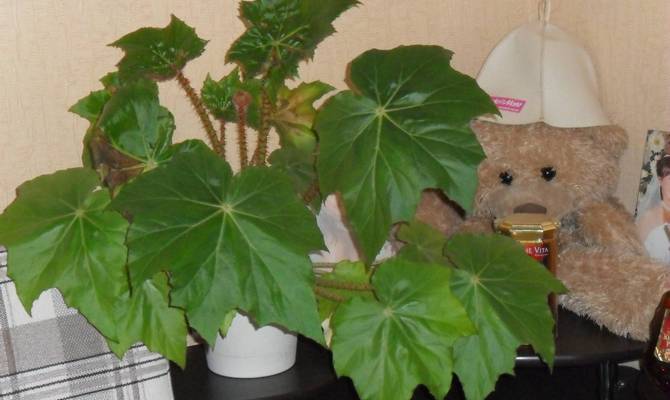

Indoor begonia
If exposure to direct sunlight is accompanied by stagnation of water droplets on the leaves, numerous holes are formed in these places, damaging the structure of the leaf plates. The pallor of the leaves and their yellowing may indicate insufficient watering or illumination. This is especially true of the Royal begonias with a multi-colored palette of colors from red to dark brown.
Begonia Royal was first found in 1856. According to Chinese legend, it is called a flower that emerged from the ground watered with the tears of a woman in love.
Treatment of begonias with fungicides and pesticides
- protective fungicides - used mainly for the purpose of prevention and as a means to protect healthy plants
- systemic fungicides - their purpose is to protect new shoots that form after treatment. They are used for both treatment and prevention - they are able to be absorbed by plants in a short time.
- medicinal fungicides - used in the treatment of plants
- contact preparations - have a protective effect only on certain parts of plants, moreover, they are dependent on precipitation
- seed dressers - they are used to treat planting material (seeds, tubers, rhizomes, bulbs, corms) to prevent various diseases
Treatment
If you do not want to treat a flower with "chemistry", keep in mind that there are so-called folk recipes in floriculture. They are safe, environmentally friendly and have already been tested.
There are some easy ways to bring begonias to life.
- Fungus. To do this, you can prepare marigolds in advance. Dry and crushed raw materials are insisted for two days and filtered. Begonia needs to be watered as usual, but with the inclusion of vegetable infusion.
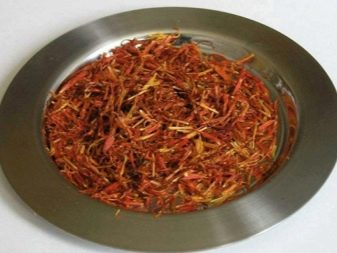

- Aphids, thrips, spider mites. You can save begonia from them with the help of potato tops. It should be kept dry or fresh in water for about 3 hours. A little crushed laundry soap should be added to this composition. Spraying with this solution occurs in the evening.
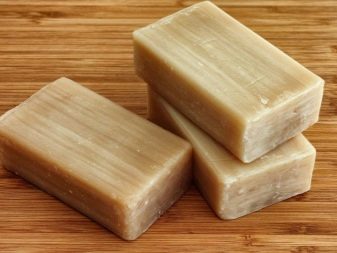

- Whiteflies, pseudothyroids. Use dandelion to revive the flower. The roots of the medicinal plant are poured with water and infused for 2 hours, then filtered. It is necessary to spray begonia with dandelion infusion immediately after the detection of the parasite.
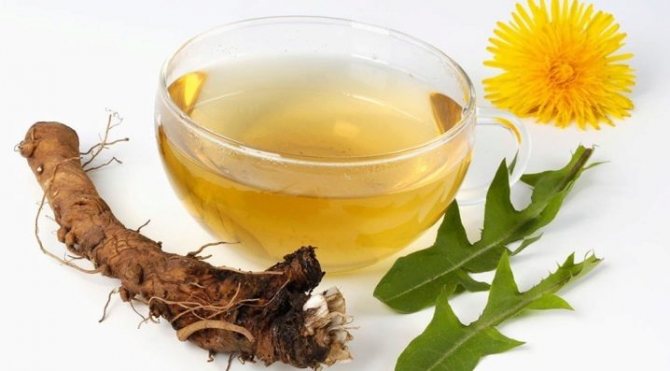

- Gray rot. If this disease has attacked the plant, you need to mulch the soil with chopped pine needles.
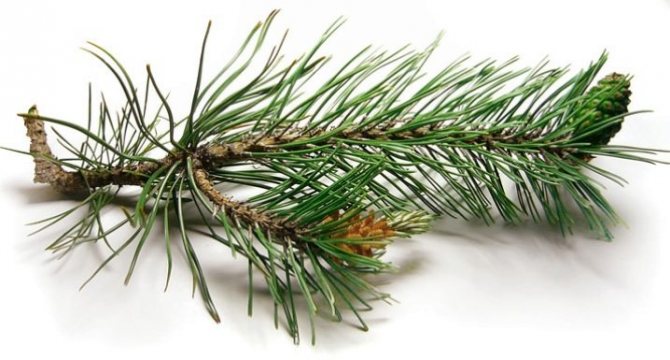

Always choose a fairly mild dosage.Even herbal remedies can cause begonia burns. It is worth noting that if a massive outbreak of the disease, an invasion of pests is recorded, then herbal infusions and decoctions will not be enough. We'll have to reinforce the treatment with chemicals - only such a fight is effective.
Defeat by aphid greenhouse
Insects feed on plant sap, as a result of which the leaf plates begin to turn yellow, the buds freeze without blooming, and the flowers crumble. Insects are usually found on the back of the leaf. Their appearance is hard to miss: aphids excrete excrement, which makes the leaves dirty.
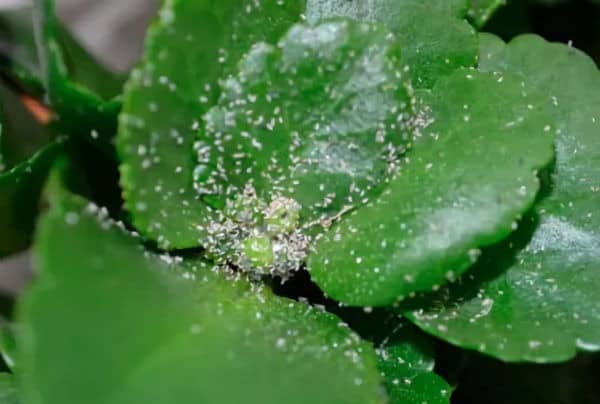

In the fight against aphids, irrigation of plants with a solution of household or green soap or tincture of tobacco will help. If we are talking about planting in greenhouses, it would be more expedient to use Benzophosphate, Aktelik, Kroneton, Selekron.
Removing damaged leaves
To keep begonia looking attractive, you need to prune it regularly. If you neglect the procedure, the plant will stretch out, the leaves will become smaller, and the buds will no longer form.
Sanitary pruning is required periodically. Damaged leaves not only spoil the appearance of begonias, but become sources of further spread of infection.
For any type of trimming, the cut points must be processed. They are sprinkled with charcoal powder to help the plant heal the cut faster.
After pruning, the flower is watered sparingly until new shoots grow. Only then can you add top dressing.
Tuber awakening
The wintering period ends in begonia in March-April. Remove the tubers from the wintering area and warm them up in the room. You can also germinate them in wet peat or sand before planting in open ground. Before that, immerse them in a potassium permanganate solution for a while.
In the presence of many buds on one large tuber. Before planting, you can cut it into pieces. Cut off places treat with ash, sulfur or charcoal.
Young plants have elongated shoots by spring, they need to be cuttings and rooted in separate containers.
Compliance with these simple storage rules will help you enjoy the summer lush and abundant flowering of the beautiful begonias.
Photo
Next, you can see a photo of tuberous begonia:
selo.

